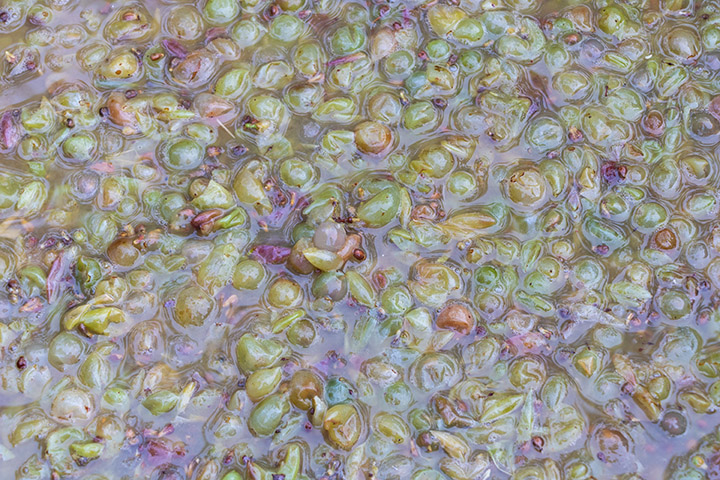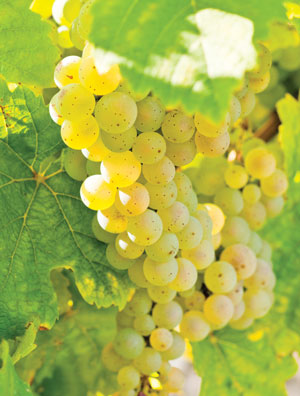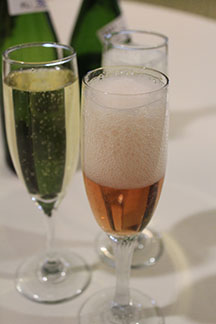15 Wine Kits to Try
Most home winemakers have limits on their winemaking space, equipment, cellar capacity or the ability of their liver to keep up. If you are one of those who has to pick and choose, this article could be a sort of personal bucket list, especially if like a lot of folks you’ve found a “house” wine that suits you well, and that you make repeatedly. It’s time to spread out and try something new, perhaps a new varietal or style, or even a new type of wine altogether.

Table wines part one: Whites
The most popular white wines in North America today are Chardonnay, Riesling, Sauvignon Blanc, Gewürztraminer and Pinot Gris/Grigio. It’s easy to understand why — the grapes grow well in most vineyards and make pretty good wines. Looking outside the box, however, there are a lot of dry table wines out there that have wonderful flavors and aromas that are completely different from the big five and yet still delicious and drinkable.
1. Viognier
If you like Chardonnay for its richness and ability to deliver a lush mouthful of fruit, you could try Viognier. Viognier is late ripening with grapes that are high in extract, sugar and potential alcohol. It is very aromatic, making lush, exotically perfumed, wines with a bouquet of honeysuckle, ripe apricots, peaches and spice, refreshed by a subtle touch of acidity. It can even soak up a good dose of oak for extra richness.
2. Chenin Blanc
If Riesling’s floral notes are your thing, you could try Chenin Blanc. Bright and aromatically fruity, Chenin Blanc combines flavors and aromas of green apple and greengage plum with floral nuances, minerals and sometimes a bit of grassiness. The nose may give an impression of sweetness even if the wine is fully dry.
3. Trebbiano
Fans of Sauvignon Blanc’s lightness and crisp acidity can get a different take with Trebbiano. Crisp, bright and refreshing, Trebbiano is almost always high in acidity, with citrus and floral notes, and in really special examples the aroma of Magnolia blossoms, along with good minerality. An added bonus to this wine is that it usually drinks quite well young.
4. Moscato/Muscat
If you want something similar to Gewürztraminer, with good fruit and soft lush character, Moscato/Muscat should be on your radar. Moscato’s most distinctive trait is its fragrance, an exotic bouquet of tropical fruit, flowers, rose petals and citrus blossoms. These impressions carry onto the palate with the rich flavors of fresh grapes and a touch of acidity.
5. Pinot Blanc
Fans of Pinot Gris/Grigio know what they like: crisp, supple wines with white fruit flavors — hints of apple and pear — with a subtle nuttiness. If you want to see what the other half of the family is like, Pinot Blanc is an excellent varietal. Descended from a cross of Pinot Noir and an obscure Burgundy grape called Gouais Blanc, Pinot Blanc is a sibling of Pinot Gris. It has delicate aromas and fresh, creamy fruit — again, pears and apples — along with notes of spice or minerals depending on soil type. It responds well to a dab of oak, getting more serious and rich.
Table wine part two: Reds
The most popular red wines today are Cabernet Sauvignon, Merlot, Pinot Noir, Syrah/Shiraz, and Zinfandel — and no wonder, as this lineup includes the tannic, the fruity, the austere, the friendly and the downright lush. But they’ve got lots of varietal company in the world of kits.
6. Sangiovese
If Cabernet’s your bag, you could go to the spicy side and try Sangiovese. This Italian grape makes bone-dry, earthy, tannic wines of medium body, strong acidity and cherry fruit offset by notes of herbs, and like Cabernet, it can evolve to a velvety softness over time. Also like Cabernet, it takes well to oak contact, which adds notes of vanilla and tobacco.
7. Carmenère
Merlot is Cab’s little brother, the one who made the pep squad instead of the football team. But that’s okay: if you like its black cherry notes and roundness, you’ll like Carmenère. It is a late ripener, with relatively low acid, which can make for a tricky balancing act in the winery, but fully ripened Carmenère shows sweet, black cherry fruit and spice flavors supported by rounded, plummy tannins and notes of grilled meat and coffee.
8. Vieux Chateau du Roi
If the strawberry/cherry notes and rounded fruit of Pinot Noir attracts you, you could try making Rhône-style wines, particularly the ones kit manufacturers label Vieux Chateau du Roi. Based on the classic Châteauneuf-du-Pape red, this is full-bodied yet wonderfully soft and early maturing. Deep red with complex flavors of red fruit, berries, plum, spice and usually well integrated oak, it’s one of those wines that will always be in short supply no matter how much you make.
9. Malbec
Syrah/Shiraz is fruity, with distinct notes of blueberry and blackberry and nicely balanced tannins. A great analogue for this grape is Malbec. This vine produces tiny, thick skinned, blue-black berries brimming with color, ripe tannins and lush fruit character. The wine is a dark purple, highly perfumed, and offers rich, luscious blackberry and damson, and aromas of violets and tobacco, well supported by ripe, juicy tannins, and usually fairly aggressive oak.
10. Barbera
For the Zin fan, the robust, spicy berry fruit never fails to work in any situation or with any food. Another extremely likeable, robust and food-friendly wine is Barbera. Native to Piedmont, Barbera is prolific in hot climates, but can achieve higher quality in cooler climates, which bring long ripening periods and rich, ripe fruit. Relatively gentle tannins balance a backbone of acidity, and rich red and black berries that can be offset by a bit of rustic earthiness.
Thinking pink: The other red white
North Americans have been soaking in a lot of very pretty pink wine. Since they were popularized by Sutter Home in the 1970s, “white” versions of red wines like Zinfandel, Merlot, Cabernet and many others have been responsible for an awful lot of quite sweet, but usually very refreshing wine. Other countries, however, take pink wine a lot more seriously than we do. France, Italy and Spain all make robust, dry, spicy rosé wines that bridge the tannins of a red with the crisp, refreshing drinkability of a white — pretty much a match made in heaven.
11. Dry rosé
For many years kit manufacturers were convinced that dry rosé wines would suffer consumer rejection, so they stuck with tried and true sweet versions. That has changed, and dry rosé is now on offer from the major manufacturers as recurring seasonal releases — a sign that perhaps it will become a permanent offering one day. Almost always a blend of red and white grapes, these wines are usually medium-bodied, with flavors and aromas of cherry and strawberry over subtle herbaceousness and a palate of stone fruit balanced with good acidity — although rarely as sizzlingly bone-dry as some commercial French rosés, they do have a crisp finish.
Fortify yourself
Fortified or sweetened wines have a rather poor reputation these days. But despite the low-urgency marketers feel from the demographic, sales are steady and nobody doesn’t like a glass of these rich wines with a proper dessert.
12. Sherry
The one wine that consistently gets a short shrift from the fortified side is Sherry. When most people hear the word “Sherry,” they think “terrifically sweet,” and “maiden aunties playing whist,” but it doesn’t have to be that way. Sherry kits are no more trouble to make than regular wines, and the finished product is an extremely versatile drink, going extremely well with salty, rich foods. Dry Sherries range from light straw to deeper tawny color and have lovely nutty flavors, and are very refreshing when drunk chilled on a sunny patio. The characteristic aroma associated with sherry is hazelnuts and hints of raisin. Sweet or Oloroso Sherry versions are walnuttier, with notes of caramel and figs, and they go well with sweet desserts or very salty cheeses.
13. Flavored Port
Many people consume Port as dessert instead of with it, and one way to make this work even better is to blend them with natural flavors of bittersweet chocolate, orange, cherry, raspberry, caramel, apples, nuts and white chocolate — not all at the same time! If you haven’t tried any wine like this before, it helps to think of it like making liquid truffle (the candy, not the fungus). Sweet, but balanced by rich fruit and deeper notes of dark, sugary flavors, these wines are brilliant in small glasses.
Put a little sparkle in your life
14. Sparkling wine
While it’s actually not that difficult to make at home, traditionally only one manufacturer made a sparkling wine kit, and that was discontinued in 2012. But that shouldn’t stop truly dedicated home winemakers — any kit can be sparkling wine if you want it to be. It does take a few more steps, and you have to be patient while it carbonates, but in no time at all you can be “tasting stars.”
15. Restricted Quantity/Limited Edition/Cellar/Collection
The final wine I recommend you try isn’t a wine at all. It’s part of the manufacturer’s winemaking programs. Every one of them has a once-a-year program that releases several different wines not seen in the regular line-up, Restricted Quantity/Limited Edition/Cellar/Collection. Some offerings in these programs are familiar varietals from unusual or up and coming growing areas, others are varietals that haven’t been seen in the home winemaking scene yet, and still others are new and interesting blends, while still others are completely familiar, but from fabulous, famous vineyards that wouldn’t normally be accessible to grape winemakers.
The two things they have in common are first that they’re limited: normally you have to pre-order to get what you want, and when the program is over, you don’t see these wines again. Second, these kits always punch way above their weight class. Because the kit manufacturers don’t have to inventory them (they make ‘em and ship ‘em the day of the deadline), don’t have to plan for year-round production, and can make large bulk purchases to satisfy the program, they can hold costs on what would normally be among their most expensive kits, and for the most part they pass that along to you, the consumer.





